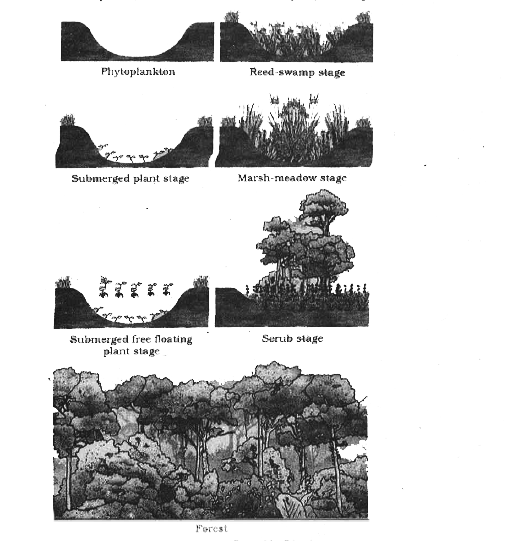What is ecological succession ? Explain hudrarch succesion.Solution in Kannada
That occurrence of relatively definite sequence of communties over a long period of time in the same area resulting in establishment of stable or climax community is known as ecological or biotic succession.
Hydrosere : It involves the ecological succession in a newly formed pond, lake (or any open water areas) and successional series progress from hydric to the mesic conditions . It involves the following ecological succession .
- Pioneer stage : The pioneers are phytoplankton consisting of unicellular and colonial forms of green plants algae near the surface of water. They are followed by zooplanktons like Amoeba. Paramecium and Vorticella .Death and decomposition of phytoplankton and zooplankton produce organic matter , which mixes with silt and form a soft mud which favours the growth of next stage of plants.
- Submerged stage : In a pond or lje where water is less than 10 feet deep , there may be entirely submeregd and free floating plants and some submerged and rooted at the bottom . e.g ., Hydrilla , vallisneria , Elodea , Ceratophyllum etc.
Death and decay of these plants and dead materials sinking to the bottom and addition of sand and silt around the plants results in rise in rise of soil at the bottom . This makes at pond of lake more shallow and unsuitable for the submerged species but suitable for rooted floating plants.
Floating stage: It consists of rooted hydrophytes with roots , rhizome or root stock attached at the bottom of the pond. Some of these plants have their leaves spread over the surface of water while some have free floating leaves e.g Nymphaea, Nelumbo , Trapa , Salvia , Azolla etc. the large leaves of many of these plants cut off light to the submerged plants. Hence with very little light it becomes of the pond or lake and the edges become more shallow (1-3 ft)
- Read swamp stage : In shallow water marshly plants like Typha, Rumes , Sagittaria invade and establish . These plants are rooted at the bottom and are partly submerged but their shoots.
extend well above the water . They cut light from the floating plants and they find it less favourable. Such plants die adding the organic matter to the soil . In course of time , the edges of the pond or lake is converted into water- saturated place(marshy place) favourable for the marsh - meadow stage.
- Marsh -meadow stage: (Sedge - meadow stage) Marshy edges with one or two inches of water of ponds or lakes favour the growth or members of family Cyperaceae and Gramineae such as Carex , Cyperus , Juncus ,Eleocharis, Fucus, Sedges and tall grases , forming a meadow (mat) like vgetation. Slowly the surface water dries up and develops a mesic condition in the area and the marshy vegetation dissappears gradually.
- woodland stage: In the moist climate , the woodland stage consists of shrubs and small trees like salix (shrubby willows) . populus (cotton wood ) and tress willows . The pioneers of this will be those that can tolerate partial water- lodged conditions around their roots . The woody plants in the region cast shade and make the soil dry by their vigorous transpiration and holding the wind - brone soil and accumulating plant debris . Meneralizaton and soil formation favours the growth of herbs among the shrubs and trees .
- Forest stage: It is the climax stage during course of time, in which the soil becomes rich in humus and organic matter and supports climax community . it may be tropical deciduous or monsoon or monsoon forests in regions of moderate rainfall , tropical rain forests in areas with heavy rainfall and mixed forests or Quercus (oak), Acer and Alnus in temperate regions

Topper's Solved these Questions
- ECOSYSTEM BOOK - SUBHASH PUBLICATIONCHAPTER - ECOSYSTEM EXERCISE - THREE MARKS QUESTION WITH ANSWERS
5 Videos
- BIOTECHNOLOGY AND ITS APPLICATIONBOOK - SUBHASH PUBLICATIONCHAPTER - BIOTECHNOLOGY AND ITS APPLICATIONEXERCISE - FIVE MARK QUESTIONS AND ANSWERS
3 Videos
- ENVIRONMENTAL ISSUESBOOK - SUBHASH PUBLICATIONCHAPTER - ENVIRONMENTAL ISSUESEXERCISE - FIVE MARKS QUESTIONS AND ANSWERS
7 Videos
Similar Questions
Write any four functions of an ecosystem.
View SolutionWhat is gene therapy? Explain the types. Add a note on its applications?
View SolutionWrite a note on groundwater depletion and ways for its replenishment.
View Solutionपारिस्थितिक अनुक्रमण किसे कहते हैं ? खाली नग्न क्षेत्रों में पारिस्थितिक अनुक्रमण किसे कहते हैं?
View SolutionWhat is ecological succession ?
View SolutionWhat is ecologycal succession ?
View SolutionWhat is meant by ecological succession ?
View SolutionWhat is meant by ecological succession?
View SolutionWhat is meant by ecological succession?
View SolutionWhat is ecological succession? Describe the succession of plants in a pond.
View Solution(a) What is ecological succession?
View SolutionWhat is ecological succession ? Explain succession of plants on a bare rock .
View SolutionWhat is an ecological succession ?
View SolutionWhat are ploner species in ecological succession ?
View SolutionWhat is meant by ecological succession?
View Solution
